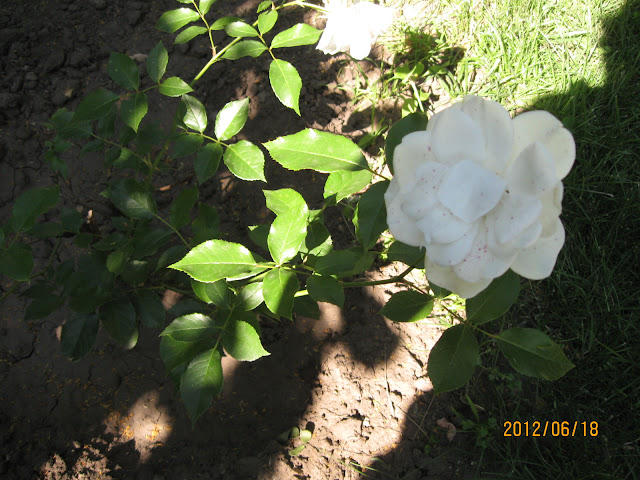Seeing some flowers can trigger memories and feelings. This happened to me these days and it reminded me about an upcoming date in the Romanian calendar. They always make me think of the supernatural. Here is a picture of the flowers - Sânziene and info about what they represent.
Fairies’ Night -Every year on
June 24, Romanians celebrate Sânzienele. The night preceding this day is believed to be
magic - miracles are possible, beneficial and negative forces reach their peak.
It’s an annual festival
in the fairies' honor.
This is similar to the Swedish Midsummer
holiday, and is believed to be a pagan celebration of the summer solstice
in June. According to the official position of the Romanian Orthodox Church, the customs
actually relate to the celebration of Saint John
the Baptist's Nativity, which also
happens on June 24.
Sânziană is the Romanian name for gentle fairies who play an
important part in local folklore, also used to designate the Galium verum
or Cruciata laevipes flowers. Etymologically,
the name stands for sân (common abbreviation of sfânt -
"saint", "holy") and zână
(a word used for fairies in general). Another likely etymology is that the word
comes from the Latin
Sancta Diana, the Roman goddess
of the hunt
and moon,
also celebrated in Roman Dacia (ancient Romania). Diana was known
to be the virgin goddess and looked after virgins and women. She was one of the
three maiden goddesses, Diana, Minerva and Vesta, who swore never to marry.
The dance of the fairies - The legend says that Sânzienele are some very beautiful girls who live in the woods or fields. They come
to dance and "empowering" special flowers and weeds, making herbal
medicines, good for all diseases. People believe, in the Sânziene night, fairies fly through the air or
walk on earth. They sing and share the fruit crops, impregnate wives, breed
birds and animals, heal the sick, protect crops from hail. If people do not
celebrate them properly, they get upset and become like bad fairies. Sânzienele revenge on women who do not hold
celebrations on June 24, cursing their mouth. Not even men do easily escape.
Those who had sworn falsely before, or have made others bad things, can expect
terrible punishment, because Fairies are great lovers of justice.
Sânzienele represents an opportunity for young people,
who want to unite their destinies, to meet, a celebration of love, rightly
honored with song and dance. On the eve Sânziene, girls and boys who are to marry in the village gather in the evening. Everybody
has fun. Boys lit pyres. Unmarried girls (virgins) pick up the representative
flowers and intertwine garlands. Then they throw these crowns over their
houses. If they crash or hang on the horn, they announce a forthcoming wedding.
In some regions,
the girls may keep the wreaths until the following year's Sânziene.
This, they believe, ensures a fertility for their family's land. In addition,
if they place the wreath under their pillow the night right after Sânziene,
it is possible that they would have a premonition
of the man they are to marry (ursitul, "the fated one").
Another folk belief is that during the Sânziene night, the heavens open
up, making it an adequate time for making wishes and for praying, as God is
more likely to listen.
At dawn the boys gather in bands and cross
the village with Sânziene flowers on their hats. The village chooses
a "Dragaica". She is proposed from a group of seven girls. She must
be the most beautiful, the best and the most diligent of the village girls. She
will be adorned with ears of wheat. The other young women will dress in white. This
is the procession Dragaica which goes through the village and the fields. At
crossroads, girls dance and sing cheerful.
Bathed in dew
This ceremony includes the whole village. Households receive an ear of wheat, which is placed on the beam in the barn. They hope the crop to be that tall. Elders say that during that night fairies and witches gather and dance in the woods. Who sees them gets mad or remains mute forever. They also believe that those who does not respect the Dragaica can have many misfortunes- the one who washes, sews and sweeps that day may die of lightning. People say that the girls who want to marry soon have to be wash with dew. But for this bathing ritual to be successful, there are certain conditions. It as to be at dawn, in places unseen by people before, old women gather the Sânziene dew in a white new cloth, cloth, then squeeze it a new pot. On the way home, they do not speak at all and must not meet anyone. If all these are fulfilled, who washes with this dew will be healthy and loving throughout the year. Married women can make this ritual too as to be loved by her husband the whole year and have beautiful and healthy children.
The consequences of heavens opening on Sânziene are connected by some to paranormal events reported during that period of each year. According to popular beliefs, strange things, both positive and negative, may happen to a person wandering alone on Sânziene night. Strange ethereal activities are believed to happen especially in places such as the Băneasa forest (near the capital of Bucharest) or the Baciu forest (near the city of Cluj-Napoca).
Mircea Eliade's novel, Noaptea de Sânziene (translated as The Forbidden Forest), includes references to the folk belief about skies opening at night, as well as to paranormal events happening in the Băneasa Forest.
I don't know if these flowers trigger any feelings in you but roses surely do. Here are some- feel away.




No comments:
Post a Comment